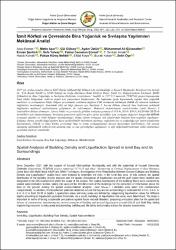| dc.contributor.author | Erener, Arzu | |
| dc.contributor.author | Aşçı, Metin | |
| dc.contributor.author | Gülsoy, Gül | |
| dc.contributor.author | Üstün, Aydın | |
| dc.contributor.author | Güvenaltın, Muhammet | |
| dc.contributor.author | Şentürk, Erman | |
| dc.contributor.author | Yalvaç, Sefa | |
| dc.contributor.author | Canaslan Çomut, Fatma | |
| dc.contributor.author | Irmak, T. Serkan | |
| dc.contributor.author | Konak, Haluk | |
| dc.contributor.author | Küreç Nehbit, Pakize | |
| dc.contributor.author | Kaya, Efdal | |
| dc.contributor.author | Kotan, Burak | |
| dc.contributor.author | Öye, Selin | |
| dc.date.accessioned | 2024-01-11T06:35:31Z | |
| dc.date.available | 2024-01-11T06:35:31Z | |
| dc.date.issued | 2022 | en_US |
| dc.identifier.citation | Erener, A. Aşcı, M. Gülsoy, G. Üstün, A. Güvenaltın, M. Şentürk, E. Yalvac, S. Canaslan Çomut, F. Irmak T.S. Konak, H. Küreç Nehbit, P. Kaya, E. Kotan, B.Öye, S. (2022). İzmit Körfezi ve Çevresinde Bina Yoğunluk ve Sıvılaşma Yayılımının Mekânsal Analizi. Doğal Afetler ve Çevre Dergisi, 8(1), 111 - 121.
https://doi.org/ 10.21324/dacd.943637 | en_US |
| dc.identifier.uri | https://doi.org/ 10.21324/dacd.943637 | |
| dc.identifier.uri | https://dacd.artvin.edu.tr/tr/pub/issue/68003/943637 | |
| dc.identifier.uri | https://hdl.handle.net/20.500.12508/2966 | |
| dc.description.abstract | 2017 yılı Aralık ayından itibaren KOÜ Harita Mühendisliği Bölümü’nün yürütücülüğü ve Kocaeli Büyükşehir Belediyesi’nin desteği ile “Çok Bandlı InSAR ve GNSS Tekniği ile Doğu Marmara (İzmit Körfezi) Düşey Yönlü Yer Değiştirmelerin İzlenmesi, Zemin Çökmeleri ile Bina Yoğunluğu ve Sıvılaşma İlişkisinin Araştırılması” başlıklı ve 117Y155 numaralı TÜBİTAK projesi kapsamında İzmit körfez bölgesinde risklerin tespiti için çalışmalara başlanmıştır. Bu bağlamda, proje kapsamında yapılan bina yoğunluk analizleri ve sıvılaşmanın körfez bölgesi çevresindeki mekânsal dağılımı CBS ortamında bütünleşik olarak ele alınarak mekânsal dağılımları incelenmiştir. Zemindeki yüke ait bilgi çıkarımı için binaların 3. boyutu dikkate alınarak bina katlarının mekânsal dağılımları mekânsal otokorelasyon çalışmaları ile irdelenmiştir. Mekansal otokorelasyon analizlerinden Lokal Moran’s I istatistikleri dikkate alınmıştır. Ayrıca körfez ve çevresinde görülen sıvılaşma potansiyeli 0-3 m, 3-6 m, 6-9 m, 9-12m’den 33-35 m derinlikleri için oluşturulmuştur. Sıvılaşma potansiyel eşiklerine göre, farklı derinlikler için, sıvılaşma değerleri kategorize edilerek sıvılaşma alanları ve riskli bölgeler tanımlanmıştır. Sonuç olarak sıvılaşma risk alanlarında bulunan bina tespitleri yapılmıştır. Çalışma; ileriye yönelik doğal afetlere karşı sürdürülebilir önlemlerin alınması, yapılaşma hızı ve yoğunluğu için önlem planlarının hazırlanması, Gölcük ve İzmit Körfez çevresinde bina ve zemin sıvılaşmalarının mevcut durumunun belirlenmesi, risk taşıyan alanlarda mühendislik tedbirlerinin alınarak yapı ve can güvenliğinin sağlanması ve afet değerlendirmelerinde altlık oluşturması açısından önem arz etmektedir. | en_US |
| dc.description.abstract | Since December 2017, with the support of Kocaeli Metropolitan Municipality and with the leadership of Kocaeli University Geomatic Department, TÜBİTAK project numbered 117Y155 and titled “Monitoring of Vertical Displacements in East Marmara (Izmit Bay) with Multi-Band InSAR and GNSS Techniques, Investigation of the Relationship Between Ground Collapse and Building Density and Liquefaction" studies have been initiated to determine the risks in the Izmit Bay area. In this context, the spatial distribution of the building density analyzes and the spatial distribution of liquefaction around the gulf region were handled and integrated in the GIS environment within the scope of the project. The spatial distributions of the building floors were examined by spatial autocorrelation studies, taking into account the 3rd dimension of the buildings for the extraction of information about the load on the ground. Among the spatial autocorrelation analysis, Local Moran’s I statistics were taken into consideration comparatively. In addition, the liquefaction potential observed around the bay and its surroundings is evaluated for 0-3 m, 3-6 m, 6-9 m, 9-12 m from 33-35 m depths. Liquefaction areas and risky areas are defined by categorizing liquefaction values for different depths according to liquefaction potential thresholds. As a result, buildings in liquefaction risk areas were determined. The study is important in terms of taking sustainable precautions against future natural disasters, preparing precaution plans for the speed and density of construction, determining the current situation of building and ground liquefaction around Gölcük and Izmit Bay, taking engineering measures in risky areas and providing building and life safety and creating a basis for disaster assessments. | en_US |
| dc.language.iso | tur | en_US |
| dc.publisher | Artvin Çoruh Üniversitesi | en_US |
| dc.relation.isversionof | 121. 10.21324/dacd.943637 | en_US |
| dc.rights | info:eu-repo/semantics/openAccess | en_US |
| dc.subject | İzmit körfezi | en_US |
| dc.subject | Sıvılaşma | en_US |
| dc.subject | Bina kat yoğunluğu | en_US |
| dc.subject | Mekânsal otokorelasyon | en_US |
| dc.subject | Izmit bay | en_US |
| dc.subject | Liquefaction | en_US |
| dc.subject | Building floor density | en_US |
| dc.subject | Spatial autocorrelation | en_US |
| dc.title | İzmit Körfezi ve Çevresinde Bina Yoğunluk ve Sıvılaşma Yayılımının Mekânsal Analizi | en_US |
| dc.title.alternative | Spatial Analysis of Building Density and Liquefaction Spread in Izmit Bay and its Surroundings | en_US |
| dc.type | article | en_US |
| dc.relation.journal | Doğal Afetler ve Çevre Dergisi | en_US |
| dc.contributor.department | İskenderun Meslek Yüksekokulu -- Harita ve Kadastro Bölümü | en_US |
| dc.identifier.volume | 8 | en_US |
| dc.identifier.issue | 1 | en_US |
| dc.identifier.startpage | 111 | en_US |
| dc.identifier.endpage | 121 | en_US |
| dc.relation.publicationcategory | Konferans Öğesi - Ulusal - Kurum Öğretim Elemanı | en_US |
| dc.contributor.isteauthor | Kaya, Efdal | |
| dc.relation.index | TR-Dizin | en_US |
















